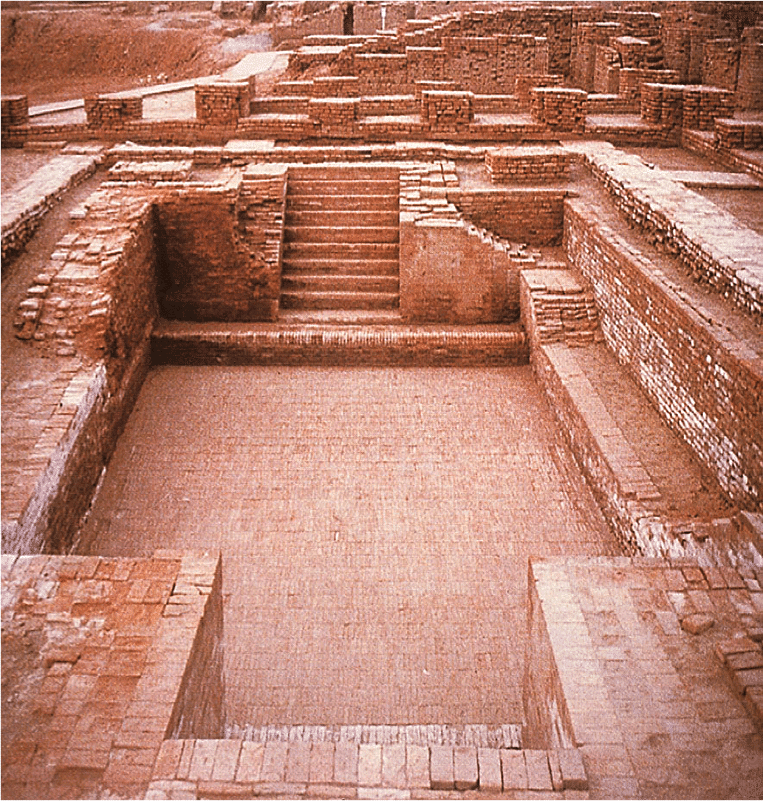Class 12 History Short Questions with Answers - Bricks, Beads and Bones
Q1: Explain how different methods of irrigation were developed for agriculture in the Harappan site.
Ans:
- Most of the sites could be found in semi-arid regions, indicating the practice of irrigation.
- Traces of canals have been found in Shortughai in Afghanistan.
- Wells might be the second source for irrigation.
- Water reservoirs found in Dholavira (Gujarat) suggest storage of water for irrigation.
 Well Used For Irrigation
Well Used For Irrigation
Q2: Mention any two methods adopted by the Harappans for increasing the agriculture production.
Ans: To increase agriculture production, Harappans used:
- Animal power such as oxen to plough the fields.
- Wooden plough was used for tilling fields.
- Canals to water the fields.
- Water was also drawn from wells for irrigation.
Q3: Mention any four items found in the graves of the Harappan.
Ans:
- Pottery
- Jewellery
- Ornaments
- Copper mirrors
Q4: Mention the two sections of the Harappan settlements and give one main feature of each.
Ans: The Harappan settlements were divided into two sections: The Citadel and the Lower Town.
Features:
- The Citadel was smaller but higher than the Lower Town and was walled.
- In the Lower Town, several buildings were built on platforms, and all building activity within the city was restricted to a fixed area on the platforms.
Q5: What was Lapis Lazuli?
Ans: It was a blue stone with very high value. Lapis Lazuli
Lapis Lazuli
Q6: Give any two features of Harappan writing.
Ans: Harappan seals usually have a line of writing, which remains undeciphered still today.
Features:
- It is not alphabetical and has too many signs, somewhere between 375 and 400.
- The script is written from right to left.
 Harappan Writing
Harappan Writing
Q7: Harappan cities had planned drainage system. Elaborate.
Ans: One of the most distinctive features of the Harappan cities was a well-planned drainage system.
- The drains were made of mortar and gypsum.
- They were covered with big bricks and lime stones which could be lifted to clean the drains.
- It followed a grid structure with straight streets crossing each other at right angles.
- Houses were built and laid out only after the drainage system was planned and laid out.
- Every house had a drain connected to the street drains.
- The solid matter from wastewater flowing in the drains got collected in a sump.
- Water flowed into the main drains.
- All this shows that Harappan people focused on cleanliness.
 Harappan Drainage SystemQ8: Describe the bases on which archaeologists identified the centres of craft production in the Harappan culture.
Harappan Drainage SystemQ8: Describe the bases on which archaeologists identified the centres of craft production in the Harappan culture.
Ans: The bases on which archaeologists identify the centres of craft production are : - Raw materials such as stone nodules, whole shells, and copper ore.
- Tools
- Unfinished objects
- Rejected and Waste material
- Finished products
Q9: How were Harappan seals and sealings used to facilitate long distance communication? What did the sealing convey?
Ans: The sack of goods to be sent was tied at its mouth with a rope, and on the knot was affixed with wet clay in which one or more seals were pressed, leaving an impression.
- If the bag reached with its sealing intact, it meant that it had not been tampered with.
- The sealing also conveyed the identity of the sender.
Q10: Why do archaeologists and historians find Harappan script enigmatic? Explain the reasons.
Ans: Harappan seals usually have a line of writing conveying the name and title of the owner.
- Most inscriptions were short, but the longest one contains about 26 signs.
- Scripts were not alphabetical but contained too many signs, somewhere from 375 to 400.
- The scripts were probably written from right to left as some seals show wide spacing on the right side and cramping on the left, as if the engraver began working from the right and ran out of space.
- Writing has been found on a variety of objects such as seals, copper tools, rims of jars, copper and terracotta tablets, jewellery, bone rods, and signboards.
Q11: Early Harappan archaeologists found certain objects which seem unusual and unfamiliar but may have had a religious significance. Substantiate.
OR
Examine the problems faced by archaeologists in the interpretation of religious practices of Harappa.
Ans: A large number of female figures of terracotta have been found from Harappa.
- Historians believe them to be Mother Goddess figures. They were heavily jewelled and even wore head dresses.
- Rare statues of men in a standardised posture, seated with one hand on the knee, were classified as the "priest-king."
- In some instances, structures associated with ritual significance, including the Great Bath and fire altars, have been found in Kalibangan and Lothal.
- Attempts have been made to reconstruct religious beliefs and practices by examining seals, which depict ritual scenes.
- In some seals, a figure shown in a cross-legged "yogic" posture surrounded by animals has been regarded as "Proto-Shiva."
 Greath Bath
Greath Bath
Q12: Who was John Marshall? How did he mark a change in the Indian Archaeology?
Ans: John Marshall was the Director General of the Archaeological Survey of India (ASI) from 1922 to 1928, a period that marked a major change in Indian archaeology. - He was exhilarated by discovering new finds.
- He was keen to look for patterns of everyday life.
- He was the first professional archaeologist to work in India and was known for excavations in Harappa, Mohenjodaro, Sanchi, Sarnath, and Taxila.
Q13: Who was Cunningham? Mention any one source he collected to understand the Harappan culture.
Ans: Cunningham was:
- An archaeologist
- The first Director General of ASI
- He began archaeological surveys in the Indus Valley in the mid-19th century.
Source he collected:
- Harappan seal
- Terracotta objects
- Harappan inscriptions
|
30 videos|274 docs|25 tests
|
FAQs on Class 12 History Short Questions with Answers - Bricks, Beads and Bones
| 1. What is the significance of bricks, beads, and bones in the humanities and arts? |  |
| 2. How are bricks, beads, and bones used as artistic mediums? |  |
| 3. What can we learn from the study of bricks, beads, and bones in the humanities and arts? |  |
| 4. How do archaeologists and art historians analyze bricks, beads, and bones? |  |
| 5. Can bricks, beads, and bones be considered as forms of cultural heritage? |  |

















